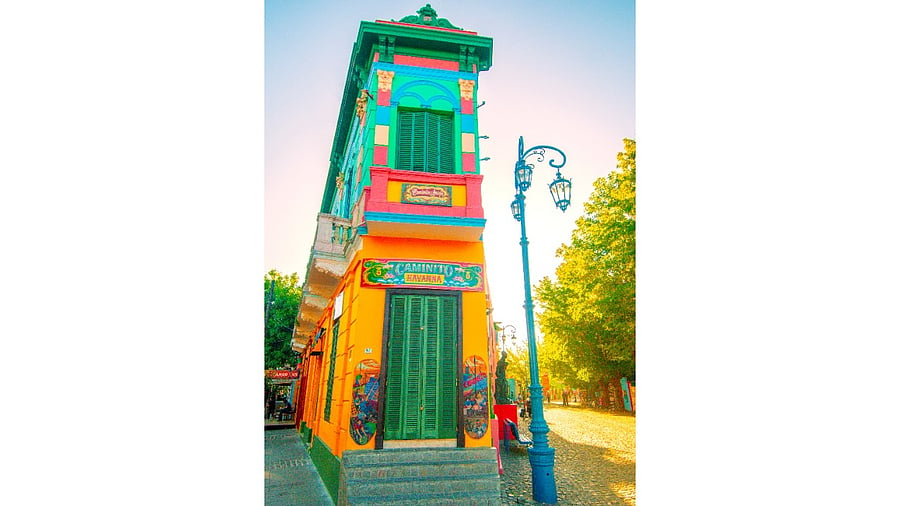
As the sun sets over Buenos Aires, Argentina, the colourful Caminito Street in the iconic La Boca neighbourhood transforms into a serene haven.
Over my two weeks travelling through Argentina a few years ago, I noticed how much a distinctively vibrant and intricate art form screams out for attention. I soon cottoned on to this, especially in the bustling streets and alleys of the capital, Buenos Aires, where it caught the eye of both locals and tourists like myself alike. Much like other street art forms I’ve seen around the world: be it the graffiti-adorned city walls of Berlin, Germany, the kitschy cycle rickshaw art of Dhaka, Bangladesh, or even our very own truck art of Punjab, fileteado porteño is iconic and symbolic of a deep set socio-cultural movement that’s been gaining momentum for over a century.
This striking style of decorative painting — that I’d come to easily identify by its dramatic brushstrokes, swirling curves, and bright, almost lurid colours — has become the epitome of the Argentine cultural identity. Locals told me that originally developed as a form of signboard art, and simply called ‘fileteado’, it has evolved into an iconic symbol of Argentina, celebrating the country’s heritage, artistic traditions, and the quotidian life of its people.
Cost-effective approach
The underpinnings of fileteado are moored in the late 19th century — a period of significant social, political, and economic change in Argentina. As the country underwent rapid industrialisation, Buenos Aires emerged as a thriving metropolis, and its urban landscape began to reflect this growth. At the time, as many small businesses and local shops were emerging across the city, their proprietors sought to create eye-catching advertisements to attract customers. However, the cost of elaborate printing and other commercial advertising methods was out of reach for many.
In response to this need, artisans and sign painters began to develop a unique and cost-effective approach to signage. They used simple tools, such as brushes, paint, and wooden boards, to create decorative signs that not only served a functional purpose but also added beauty to the urban environment. The early signs often featured the names of businesses, but as the art form evolved, it began to incorporate more decorative elements, including floral patterns, and bold lettering, with sweeping curves and curlicues.
The distinctive style of fileteado was influenced by a range of cultural sources, many even breaching Argentina’s borders. It drew on European traditions, particularly the Baroque and Rococo styles, as well as indigenous and local artistic expressions. Italian immigrants, who were prominent in Buenos Aires at the time, played a significant role in shaping the development of fileteado, blending European techniques with local flair.
Characteristic charm
Now, though fileteado is often used to embellish signboards, it can also be found on everything from murals and vehicles to personal items like guitars and clothing. Much to my joy, I saw that some of the most obvious examples of fileteado are seen on the colourful buses and trucks that crisscross the streets of Buenos Aires, with elaborate designs covering everything from the front bumper to the back windows.
The design elements of fileteado are often deeply symbolic. Flowers, birds, and other natural motifs are commonly featured, representing Argentina’s rich natural landscape. Additionally, the art form frequently incorporates Argentine symbols, such as the national flag or the image of the famous tango dancer, to evoke national pride. The stylised lettering used in fileteado is a significant feature, with curving, ornamental letters often spelling out business names or phrases in a way that emphasises both readability and visual impact.
Talking to a few art students outside Buenos Aires’s famed arts college, the Universidad Nacional de las Artes, I was made to understand that while fileteado began as a practical form of commercial art, it gradually evolved into a more formal artistic expression. By the mid-20th century, artists began experimenting with the style, incorporating new techniques and pushing the boundaries of what fileteado could represent. This transformation was especially evident in the work of prominent Argentine artists like Fernando 'Coco' Paredes and Jorge 'El Chacal' Acuña, who became known for blending fileteado with modern art movements and urban aesthetics.
Interestingly, I also saw how the influence of fileteado can also be seen in contemporary Argentine pop culture, with its distinctive style making appearances in graphic design, fashion, and even music videos. As the art form gained recognition, it was celebrated for its ability to bridge the gap between folk traditions and modern design sensibilities.
One of the most notable moments in fileteado’s history occurred in 2019 when UNESCO recognised the art form as part of Argentina’s intangible cultural heritage. This acknowledgement served as a testament to the enduring significance of fileteado and its role in preserving Argentina’s cultural history. The recognition also helped to promote fileteado as a form of cultural expression that transcends its original commercial purpose, elevating it to the status of a national treasure that it surely is.
